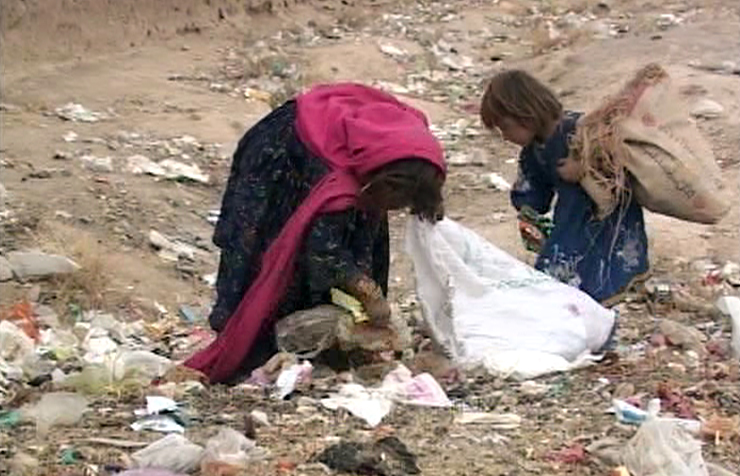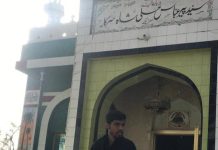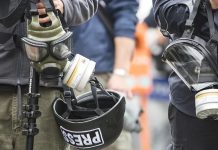Quetta: For Salma and Shazia, the scavenger girls of Quetta, the day starts quite early. They are up at 6 am and by the time it is 7 am, they are out in the streets of Quetta, grimy bags slung from fragile shoulders. Now and then, the little girls get distracted from collecting garbage and stand giggling at something. When they are approached, they grow serious and circumspect, moving away as they look back warily at you – perhaps following the parental advice not to talk to strangers. Not that such an advice would do them any good: The streets where they spend their waking hours are full of strangers. And hazards.

In the beginning all I could get out of Salma and Shazia is their ages. Salma is six, Shazia eight. And that they leave home by seven every day to gather garbage. But then they warm up to me when I ask if they like collecting garbage. In their response they are laconic and matter-of-fact, like they are adults in children’s bodies.
“No, but we have to do it for survival,” say Shazia, who stands barefoot, her toes grimy with dirt from the streets. Her sister Salma’s face and hands are already dirty even though it is early in the day or perhaps she never washed when she left home.
According to Society for Empowering Human Resources (SEHER), an organization that works on child protection, there are some 15000 street children in Quetta, the provincial capital of Balochistan province. About 60 percent of them are scavengers who wander and scour different parts of the city picking garbage. These children live in neighbourhoods populated by Afghan Refugees – Bashir Chowk, Usman road, Kashmirabad, Pashtoonabad, Western by-Pass, and Nawa Killi. During the day, they wander around the commercial streets of Kasi Road, Mezan Chowk, Baldia Plaza, and Prince Road.
A majority of street children in Quetta, according to SEHER, are Afghan refugees who came here in early eighties in the wake of Afghan Jihad and later the US-led intervention in Afghanistan in 2001. The city also has a large number of street children, garbage pickers and beggars that come from the neighbouring Sindh province and elsewhere in Balochistan.
“In Quetta, street children are extremely prone to risky behaviour and hazards including sexual and physical abuse, drug use and exploitation,” says Abdul Wadood Khan, the Executive Director at SEHER. “Most of them do not have adequate access to health, nutrition, hygiene and legal support.”
In the morning when children go to schools, Salma and Shazia pick up their garbage bags and head out for the streets. To the onlooker they may be street children preoccupied and saddled with bags full of scavenged junk, but the girls also carry the burden of a huge responsibility.
“Everyone asks about our education but no one considers the fact that we will starve if we don’t work,” says Shazia. “I like pens and books but if I start thinking about going to school instead of collecting garbage, what will my siblings eat?”
Salma, Shazia, their mother and two little brothers moved into a small rented house in Pashtoonabad in Quetta’s suburbs after their father was killed in a terrorist attack. For the last two years, Shazia has been earning for the family and now Salma has joined in to help her. “When we don’t get garbage according to our needs, I collect eatables from garbage dumps for my brothers,” says Shazia.
Surviving the Streets, a national study conducted by Society for the Protection of the Rights of the Child (SPARC), says the average weekly income for children working and living on the streets is more than PKR 800 that comes to about PKR 3,000- 4,000 a month. According to the study, the common expenditure incurred by children working in the streets is on food and family whilst those living in the streets spent most of their money on food and travelling. Street children, says the SPARC study, rarely spend money on clothing, hygiene or entertainment.
After spending their day in the streets of Quetta from morning tol twilight, Shazia and Salma are able to make about PKR 200 ($2). Shazia says that after her father died, they spent a desperate 3 days without food or money and Shazia, who was only six then, was pressed into supporting the family even before she the family was done mourning. “My brothers kept crying due to hunger,” says Shazia. “No one has helped or supported us in the two years since my father’s death. People don’t treat us nicely. The school children often laugh at us.”
Among the kinds of violence reported in all the cities surveyed under the SPARC study, physical violence is the most common, including beatings and abuse etc at the hands of police officials. Children say they are frequently harassed by the police, with bullying and beating the most common form of abuse used by the police. The study doesn’t provide much information on incidences of sexual abuse as children were not comfortable sharing such information. “However, the children did share instances where their friends have been sexually abused by their employers, the police, and even by parents and older children. Out of all the cities surveyed, Multan recorded the highest number of cases of sexual abuse by either the employers or older children on the street.”
Due to their vulnerability, children are provided the right to protection under Article 25 (3) of the Constitution of Pakistan. On November 12, 1990 Pakistan ratified United Nations Convention on the Rights of the Child (UNCRC) that provides broader outlines for the promotion and protection of child rights. While other provinces have policies to protect children, Balochistan has yet to make any progress on this account. In the post 18th Constitutional Amendment scenario where provinces are required to enact child protection laws, the civil society and child rights organizations have been demanding protection laws for the children of the province.
According to SEHER’s Abdul Wadood Khan, a significant progress in this direction has been the Child Rights Movement or CRM – a group of like-minded civil society organisations dealing with the exploitative and abusive situation of children in Pakistan. Under the CRM umbrella, close to twenty-five NGOs are working for the protection of child rights in Balochistan. While the UN and civil society organizations working with the government have been able to draft a Balochistan Child Welfare and Protection Bill in 2011 that was introduced in the provincial assembly in 2015, the bill has yet to translate into a law.
Jafar, a scavenger boy in Quetta whose father died 3 years ago, is the sole earner for his family comprising his mother and five siblings. He had his hands bandaged with dirty rags because he had injured them with shards of glass while sifting through garbage.
According to Jafar, the number of children collecting waste in Quetta is increasing by the day. “We are losing work and not getting proper money for all the waste we gather. I have to start earlier than usual so that I can get to the waste before anyone else does. My work begins at sunrise and ends at sunset. I have even started collection of waste from households and offices and I am able to collect 240 to 260 kg of waste in a month.”
Jafar said he was always on the lookout for scraps of copper which sells for a good price. He gathers waste and then sifts it into glass, plastic, paper, and toys before selling them at a local scarp shop.
“I am happy to able to support my family,” says the nine year old Jaffar. “I do my best but I regularly face hazards when it comes to work. A dog bit me eight months ago and I needed to have (rabies) vaccine but couldn’t for want of money. I often feel unwell and my mother is worried about my health.”
According to Dr. Asad Khan, an MD based in Quetta, street children children are vulnerable to diseases and hazards due to the nature of their work. He said garbage collectors are exposed e HIV, Hepatitis B and C because of handling hazardous materials, drug and sexual abuse. Chest, liver, urinary and bladder infections and skin diseases are common among them.
“There are two types of garbage collectors: The young the old,” said Dr. Khan. “The older garbage collectors are also drug addicts who do not have homes. They live under the bridge over the City Nullah – a sewage and wastewater canal running through the city. They inject drugs which expose them to deadly diseases. While the children garbage collectors are not always drug addicts using injections, they do handle garbage that could be hazardous and toxic. When they get cuts on their bodies or eat with unclean hands, they get infected with germs.”
According to Dr. Khan, the prevalence of HIV in Pakistan is not only because of sexual transmission but mainly due to drug injection. He said those who inject drugs also resort to garbage collection to make money because they are not fit for any other work. The homeless junkies and garbage collectors use garbage dumps to assemble for their fix because that is where they can hide in plain sight.
“Garbage collectors often do not have relatives who can ensure they stay under continued treatment and not relapse into a hazardous lifestyle or drug abuse,” said Dr. Khan. “They are brought to hospital by kind people who can’t see them suffering but in absence of a home or relatives, there is so much a hospital can do. As soon as they leave the hospital, they are at it again, posing a serious threat to their own wellbeing and of those they share drugs with.”



